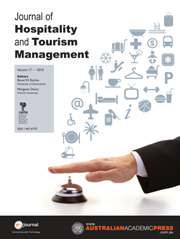Crossref Citations
This article has been cited by the following publications. This list is generated based on data provided by
Crossref.
Sharma, Bishnu
and
Dyer, Pam
2009.
An Investigation of Differences in Residents' Perceptions on the Sunshine Coast: Tourism Impacts and Demographic Variables.
Tourism Geographies,
Vol. 11,
Issue. 2,
p.
187.
Gunasekaran, Angappa
Sharma, Bishnu
and
Dyer, Pam
2009.
Residents' involvement in tourism and their perceptions of tourism impacts.
Benchmarking: An International Journal,
Vol. 16,
Issue. 3,
p.
351.
Vareiro, Laurentina Maria da Cruz
Remoaldo, Paula Cristina
and
Cadima Ribeiro, José António
2013.
Residents' perceptions of tourism impacts in Guimarães (Portugal): a cluster analysis.
Current Issues in Tourism,
Vol. 16,
Issue. 6,
p.
535.
Junid, S
Aminudin, N
and
Mustapha, N
2013.
Hospitality and Tourism.
p.
413.
Kruger, Martinette
Viljoen, Armand
and
Saayman, Melville
2013.
Who pays to view wildflowers in South Africa?.
Journal of Ecotourism,
Vol. 12,
Issue. 3,
p.
146.
Fan, Xin-qiao
Lu, Zheng-lan
and
Wu, Heng-xuan
2014.
Current Situation of Rural Residents’ Tourism: A Case Study in Zhejiang Province in China.
Asia Pacific Journal of Tourism Research,
Vol. 19,
Issue. 10,
p.
1191.
Sharma, Bishnu
and
Gursoy, Dogan
2015.
An Examination of Changes in Residents' Perceptions of Tourism Impacts Over Time: The Impact of Residents' Socio-demographic Characteristics.
Asia Pacific Journal of Tourism Research,
Vol. 20,
Issue. 12,
p.
1332.
Uysal, Muzaffer
Sirgy, M. Joseph
Woo, Eunju
and
Kim, Hyelin (Lina)
2016.
Quality of life (QOL) and well-being research in tourism.
Tourism Management,
Vol. 53,
Issue. ,
p.
244.
Figueroa B., Eugenio
and
Rotarou, Elena
2016.
Sustainable Development or Eco-Collapse: Lessons for Tourism and Development from Easter Island.
Sustainability,
Vol. 8,
Issue. 11,
p.
1093.
Ven, Seyhah
2016.
Residents’ Participation, Perceived Impacts, and Support for Community-based Ecotourism in Cambodia: A Latent Profile Analysis.
Asia Pacific Journal of Tourism Research,
Vol. 21,
Issue. 8,
p.
836.
Kim, Gyunghoon
Duffy, Lauren N.
Jodice, Laura W.
and
Norman, William C.
2017.
Coastal Tourist Interest in Value-Added, Aquaculture-Based, Culinary Tourism Opportunities.
Coastal Management,
Vol. 45,
Issue. 4,
p.
310.
Banki, Mohammed Bala
Dalil, Musa
Mohammed, Maikudi
and
Santali, Benjamin Aliyu
2018.
Influence of socio-demographics of leisure travellers on service experience equity.
Anatolia,
Vol. 29,
Issue. 1,
p.
129.
Wassler, Philipp
Schuckert, Markus
Hung, Kam
and
Petrick, James F.
2018.
You're welcome? Hong Kong's attitude towards the Individual Visit Scheme.
International Journal of Tourism Research,
Vol. 20,
Issue. 5,
p.
637.
Chea, Chiam Chooi
2018.
Open and Distance Learning Initiatives for Sustainable Development.
p.
189.
Oliveira, Ermelinda
2019.
Responsibility and Governance.
p.
113.
Lin, Chung-Hsien
Wang, Wei-Ching
and
Yeh, Yuan-I
2019.
Spatial Distributive Differences in Residents’ Perceptions of Tourism Impacts in Support for Sustainable Tourism Development—Lu-Kang Destination Case.
Environments,
Vol. 6,
Issue. 1,
p.
8.
Pavlić, Ivana
Portolan, Ana
and
Puh, Barbara
2020.
Segmenting local residents by perceptions of tourism impacts in an urban World Heritage Site: the case of Dubrovnik.
Journal of Heritage Tourism,
Vol. 15,
Issue. 4,
p.
398.
Lesik, Iryna
Lesik, Maksym
Tishechkina, Kateryna
Ushkarenko, Iuliia
Soloviov, Andrii
and
Lahoiskyi, Artem
2021.
ANALYTICAL EVALUATION OF THE PROSPECTS FOR SUSTAINABLE DEVELOPMENT OF ENVIRONMENTALLY ORIENTED TOURISM BUSINESS.
Business: Theory and Practice,
Vol. 22,
Issue. 2,
p.
318.
Ramón-Cardona, José
Peña-Miranda, David Daniel
and
Sánchez-Fernández, María Dolores
2021.
Acceptance of Tourist Offers and Territory: Cluster Analysis of Ibiza Residents (Spain).
Land,
Vol. 10,
Issue. 7,
p.
734.
Kafa, Neşe
and
Korkmaz, Halil
2021.
Overtourism, Technology Solutions and Decimated Destinations.
p.
101.




